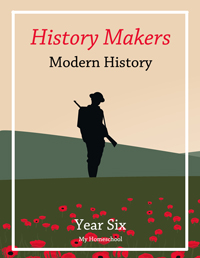This is an online version of this resource. When you buy the course it is provided in a printable PDF format.

Once a week you'll read about event and people modern history and then we get the child to write a summary or narration of what they have just read. You can read this aloud to your child (because there are interesting issues to discuss) however if you are time poor then they can read it on their own.
This resource was written specifically for My Homeschool Year 6. It has short narratable chapters. We begin our history from WWI and continue through to the 20th century. It covers significant events and significant people. This history also ties in with the historical fiction we have chosen for your child to read.
How To Use This Resource
Each lesson has a short story about a significant event or person that lived during the 20 th century. After reading through a lesson you will then write a short narration or summary.
Writing Lessons
As you mature in your reading and writing skills you will need to do something with the information you read. As a way of retaining the information you are learning in your History Makers: Modern History we use three main tools:
- The Notebook
- Book of Centuries
- End of Term Exams
You need to print off this resource so you can highlight and make notes on the page.
The Notebook
Notebooking is a tool for making a record of learning in a creative and meaningful way. You can decide how your notebook looks. It can be a folder or an art book. Put simply, it is your learning scrapbook or journal and you will use this to store your written narrations, maps and pictures. It will also be used as a reference in your end of term exams.
After you read each history lesson you will make an entry in your notebook. Adding pictures and maps is usually easy but getting thoughts down on paper can sometimes be difficult. You may find it hard to craft your sentences or work out what is important to add to your notebooks but there are techniques that can make this easier. For the first three weeks a new skill will be taught to help you write well. Your notebook will show your learning journey of your ancient history studies and your writing skill development.
For each lesson dates have been given to enter in a Book of Centuries. You can make a Book of Centuries, download a free one or buy one. Instructions for making your own can be found in the Before You Start section of this course.
End of Term Exams
At the end of term you have an opportunity to share what you remember from your modern history studies. This is not a test of what you don’t know but rather a way to share what you do know. It is also a chance to demonstrate some of the new writing techniques you will have learnt.
Using History Makers
Do one lesson per week. Chapters have been kept short to help your child stay focused. Only attempt one chapter at a time.
Most Year 6 children will be able to read these lessons on their own.
Additional Reading & Resources
Some additional books have been suggested with specific chapters. Reading this is not compulsory.
The Year 6 reading schedule also includes 4 historical fictions relevant to the period you are studying.
If you wish to find out more about particular events in your own time there is a lot to discover. There are often documentaries that can be found online and at the library about many aspects of modern history, particularly the world wars.
Chapter One: The Great War - WWI
Book of Centuries Entry - WWI: 1914 to 1918
If you were to read through the newspapers of the early 20th century you would not be surprised that a world war broke out. It seemed that Europe was getting ready for a war. Countries had gathered weapons for themselves at a rapid rate, they were seeking alliances to help them in case a war did break out. They were arguing over many things. Their guns were ready, they just needed a reason to pull the trigger.
The Great War, which we now call World War One (WWI) was triggered by a seemingly small but gruesome incident.
Franz Ferdinand, the future king of Austria-Hungary had travelled with his wife to Sarajevo to inspect the imperial armed forces in Bosnia and Herzegovina, which had been claimed as Austria-Hungarian territory since 1908. Austrian control of Bosnia angered many Serbians who felt it should be a part of Serbia.
It was their 14th wedding anniversary, 28th of June 1914, and the royal couple were riding in an open motorcar through the streets of Sarajevo to an official event and many had come out into the streets to see them pass by. From the crowd a young man stepped out and fired two shots, the first hit the Archduke in the neck, the second hit his wife in the stomach for she had flung herself forward to protect her husband. She died immediately. He died ten minutes later.
The assassin was a 19 year old Serbian man who said he wanted to take revenge on Austria-Hungary for the oppression of the Serbian people. Upon investigation, it seemed he did not act alone and Serbian links were suspected. Serbia made little effort to assist in the investigation. A wave of horror spread through Europe but the Serbian newspapers found it hard to conceal their satisfaction with the assassination.
Less than a month later, after unsuccessful attempts by Austria to get some answers and cooperation from the Serbian government, Austria declared war on Serbia. Serbia was an ally of Russia and Austria-Hungary was an ally of Germany.
At that time, Europe was divided into two main political groups. The Allies: the British Empire, France, Belgium, and Russia — were in one group. And the Central Powers of Germany, Austria-Hungary, Bulgaria and Turkey were in the other.
When Russia mobilised its troops to help Serbia, The German Kaiser who was actually the cousin of the Russian Czar then declared war on Russia. Germany then declared war on France because they were an ally of Russia. Belgium, the country between Germany and France declared its neutrality. Britain said it would defend Belgium’s neutrality and help France protect her coastline. Germany invaded Belgium and the first shots were fired on the 4th of August 1914. Britain and the other allies came to Belgium’s defence and the Great War began.
Belgium was quickly conquered, and Germany moved towards France. The fighting stopped at an imaginary line in France which became known as the Western Front which stretched across France and stopped at Switzerland.
Switzerland, which was land locked by Central powers and Allied countries remained neutral. Other European neutral countries included Portugal, Sweden, Spain, and the Vatican. But other countries joined the war to support the Allies: China, South Africa, India, Australia were among the countries who sent troops to fight.
The Western Front war was fought primarily in the trenches and not much progress was made on either side for the next four years.
The Eastern Front was primarily a war between Russia and Germany and Austria- Hungary. But after the Russian Revolution and the overthrowing of the Csar, the new communist government in Russia made a peace treaty with Germany and pulled out of the war. Germany now returned its fighting to the Western Front.
In the Middle East the combats occurred mainly between Central Powers of the Ottoman Empire with some German assistance, and the Allied forces commanded by the British were supported by Australian and New Zealand troops amongst other allied forces. One memorable battle which occurred in Gallipoli, took the lives of many Australian’s and New Zealand soldiers. It is commemorated yearly as ANZAC day.
The Battle of Beersheba occurred when the 4th regiment of the Australian Light Horse Brigade stormed the Turkish defences and seized the strategic town of Beersheeba, thus enabling the British forces to advance through to Palestine and ultimately gain control.
Although provoked to enter the war in 1915 when the Germans sank the Lusitania, a British passenger ship that had many American passengers onboard, the United States of America did not enter the first world war till its final year, but the two million fresh troops made victory possible for the allies. After a few more bloody battles the Germans were finally forced to retreat and the war ended in November 1918.
